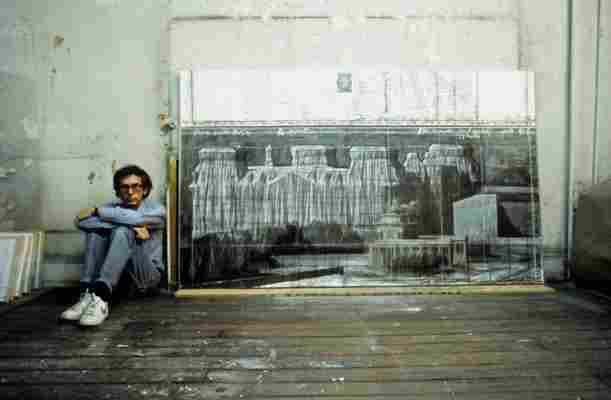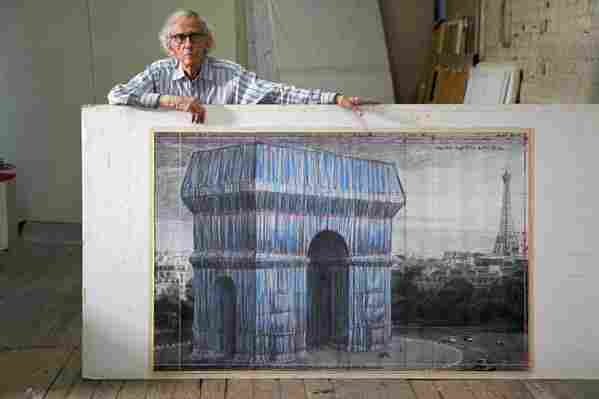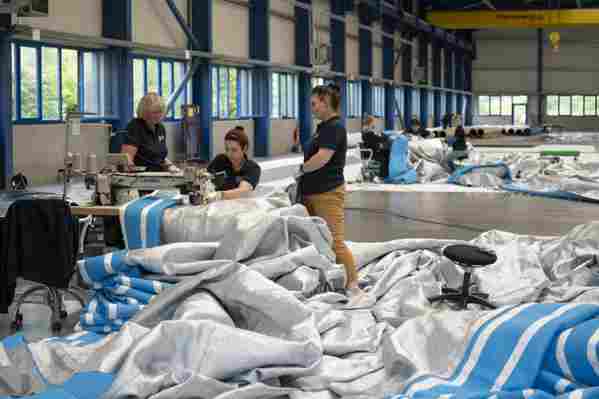Typically, it took decades for artists Christo and Jeanne-Claude to realize one of their epic and ephemeral projects. In 1971, the pair set in motion their plans to swaddle Germany’s history-scarred Reichstag in more than a million square feet of shimmering silver fabric. Wrapped Reichstag wouldn’t be completed until 1995. The Gates, Central Park was first conceived in 1979, and its 23 miles of overhead saffron panels arching 16 feet above Central Park walkways finally unfurled in 2005.
Why the long delays? “Every square meter of the world is owned by somebody,” Christo, who died at 84 years old in May 2020 , reminded me in one of our sporadic conversations in the last three decades of his 60-year career. ”This somebody can be a person, or a city, or an entire nation.”
He took delight in recalling that the entire German Parliament had to meet in debate before granting him and Jeanne-Claude permission to wrap the Reichstag. “There was a full debate in parliament for the first time in art history,” a triumphant Christo declared, hands and white hair flying. “And not only that, we defeated the prime minister who was against the project!”
Jeanne-Claude died in 2009. She had been Christo’s wife and partner-in-art from the beginning, and he focused on realizing the projects they had begun together. When none of these had materialized by 2014 and his 80th birthday was approaching, “I had to do something very fast because I don’t know how long I will live,” he told me in 2016. In those two years he had realized The Floating Piers , a 1970s project which he and Jeanne-Claude conceived for Argentina and then Japan, and which had never made it past the concept and drawing stage. In 2016, with the help of longtime friends, The Floating Piers quickly materialized as saffron-draped waterborne walkways connecting an island to the mainland in Italy’s Lake Country.

His latest project, L’Arc de Triomphe, Wrapped , came together nearly as quickly, even more remarkable as it will go up posthumously, with plans that began with Christo being seen through by his nephew.
Just as the Reichstag belongs to the German people, the Arc de Triomphe belongs to the French nation. It sits in the Place de l’Étoile as the hub of 12 Parisian avenues. At its foot every evening at 6 the Eternal Flame is rekindled in honor of the Unknown Soldier entombed below. It is a symbol of national pride. Even so, for Christo, this time the project came easy. Once he declared his desire to wrap that symbol of French freedom and power in 2018, it took a single high-level meeting between artist and officials, and the necessary permits were signed. L’Arc de Triomphe, Wrapped ( Project for Paris, Place de l’Étoile-Charles de Gaulle ) is almost ready to enact its transformative magic on Paris from September 18 through October 3.
The city of Paris, in celebration, will close the Place de l’Étoile to traffic for the three weekends of its display, making room for millions of expected pedestrians.
For 16 days, the arch, commissioned by Napoleon to honor French heroes and French victories and where Hitler’s invading armies once marched, will be wrapped in 323,000 square feet (7.4 acres) of silvery blue polypropylene fabric, which will fall in billowing pleats, catching vagrant breezes and reflecting autumn light. The drapery will be held in place with 22,960 feet (4.3 miles) of rope.
“I like having this commanding metallic quality of the silver, with a bluish reflection,” Christo explained as we spoke onstage at New York’s 92nd Street Y a year before his death. “And red ropes!” He paused a beat, smothering a gotcha grin. “But, of course. That is the color of the flag of France.”

Christo liked to point out that the monumental artworks with which he and his wife Jeanne-Claude took on—temporarily wrapping the Reichstag and the Pont Neuf in Paris, and a coastline in Australia—are as real and as exactly engineered as highways and bridges. They required the same kinds of experts in construction, law and structural planning. But he was thrilled most of all with spending endless hours on-site experiencing the alchemy with which he transfigured the everyday world into art. “This is the real world. This is the real thing,” he once told me, “the real wet, the real wind and the real kilometer. All of our projects demand some kind of physical contact with real things.”
That experience is everything. It is the culmination of what Christo and Jeanne-Claude designated the two stages of any project. First comes the “software” stage of concept, cajoling, persuading and negotiating for the essential permits. To Christo and Jeanne-Claude, the software was never merely prelude to the final event; it was as much a material as pigment to a painter. It’s a process that has been documented in a series of engaging films by the filmmakers Albert and David Maysels, and most recently the Bulgarian director Andrey M. Paovnov, recording the high drama and high stakes, the anxiety, nail-biting suspense, despair and determination that constitute a Christo and Jeanne-Claude production.

And then the “hardware” stage brings together the multiple strands of construction that lead to those fleeting days to just take joy in the artistry of it all. For all the arduous years and months of their making, the public extravaganzas exist for no more than 16 days, before they are dismantled, and the materials sold and recycled. Those long years of preparation and 16 days of glory come at a high price—at least $13 million for L’Arc de Triomphe, Wrapped —which Christo and Jeanne-Claude always self-financed through the sale of the drawing he makes for each project.
“Why is the work temporary?” Jeanne-Claude was asked, as she scouted Colorado rivers in 1996 for one of the more than 47 projects that never happened (23 did).
“There is one quality that is very, very dear to human beings and that is never used by artists,” she said. “We have love and tenderness for childhood because we know it will not last. We have love and tenderness for our life because we know it will not last. “
Christo Javacheff was barely 26 when he first made a drawing of a wrapped Arc de Triomphe. It was a pipe dream from an impecunious outsider. “It was something impossible in 1962,” he would later recall. He was a Bulgarian refugee who had escaped Soviet occupation and made his way to Paris in 1958, because he was an artist and that was where art was, he believed.* He spoke only Bulgarian and Russian, with just enough halting French to get him the portrait commissions that barely made ends meet. He was painting a general’s wife when he met her glamorous daughter, Jeanne-Claude Denat de Guillebon, born the same day as he was, June 13, 1935. Very soon, as Jeanne-Claude liked to say, Christo was learning his French in bed.
“I was living, I can tell you, in a miserable place,” he once told me, “a maid’s room in a little street just very close to the Arc de Triomphe,” and there he was doing his real artistic work.
Ever since Picasso incorporated an actual piece of rope into his 1912 painting Still Life with Chair Caning , Modern and contemporary artists have been finding increasingly porous ways to integrate the actual world with their art. For Christo in those early Parisian days, that meant converting mundane objects—bottles, chairs, telephones, even a motorcycle—into mysterious, indeterminate presences by wrapping them in bed sheets and plastic. Already he was thinking big, wondering what it would look like to wrap something important and public—like, for instance, the Arc de Triomphe at the western end of the Champs-Élysées.
On that avenue, history was taking place. “There was the Algerian War, there was the putsch of generals, the Champs-Élysées was full of tanks and armor,“ he remembered, particularly after French troops pulled out of Algeria in 1962, and 900,000 Algerians, who had become targets at home because of their cooperation through the colonial years, fled to France.
Christo and Jeanne-Claude always insisted that their work has no meaning outside itself. “These projects are useless, they have nothing to do but to be totally irrational. The world can live without these projects,” Christo often said .
However, just as the fabric alters and enhances the reflection of a passing headlight or the weight of pelting rain, the work itself cannot help but incorporate the moment of its appearance in the world. It becomes a disrupter, creating its own hyperreality, in which places usually passed without a glance instigate an intense awareness of the history, headlines, concerns and hopes that surround them.
One of the reasons L’Arc de Triomphe, Wrapped made it through the permit process so fast, Christo surmised, was because in the autumn of 2018, when the subject first came up, “Yellow Vest” protesters in Paris were demonstrating against high prices and a lopsided middle-class tax burden. French President Emmanuel Macron needed to create some good news.
And after Bernard Blistène, the director of the Centre Pompidou, Paris’ Modern and contemporary art museum, traveled to New York, where Christo and Jeanne-Claude had lived since the ’60s, Macron had it. In discussing the Pompidou’s upcoming exhibition about Christo and Jeanne-Claude’s Paris years, Blistène explained that living artists were usually asked to create a new installation for their exhibition. To everyone’s surprise, Christo declared there was only one project that would interest him: wrapping the Arc de Triomphe.
Wrapped Reichstag and its five million visitors, and The Gates with its four million visitors, had already demonstrated how Christo’s sorcery could lighten the atmosphere and heal wounds in a moment of crisis—not to mention drive tourism.
In 1995, Germany was reeling from the shock of reunification and the weight of its fraught history, and the silver of those panels translated into introspection and hope. In 2005, New York was still enshrouded in depression and paranoia after the 9/11 attacks. “Central Park is in the city where the entire misery and horror took place,” Christo said at the time. A new mayor, Michael Bloomberg, gambled that Christo’s long-denied The Gates project would help lift New York’s spirits and its economy. And those meandering miles of saffron panels waving above the walkways in the grey of a New York February did just that. Attendance jumped at hotels, theaters, restaurants and museums. Mayor Bloomberg estimated that The Gates brought in $8 million in tax revenue , and for New Yorkers like me it instigated a new buoyancy, a belief that the city was back.
Whatever teams from the Centre des monuments nationaux , the Centre Pompidou and the city of Paris did to prepare, it took only that single meeting between Christo and French officials, and the project was a go.
“It was luck. We know that,” Christo said. “The Yellow Vests were big part of the [government’s] decision to make the project.”
It won’t be until after September 18 that the full significance of L’Arc de Triomphe, Wrapped will reveal itself. Phillippe Bélaval, president of the Centre des monuments, is predicting “an unforgettable moment of shared joy.” But with the Delta variant rampant, it is doubtful that Christo’s love letter to Paris will jump-start a post-Covid reawakening as it once promised it might. Health, economic and political crises continue to proliferate, in France and everywhere. As his first posthumous gift to the world, it may seem a fitting memorial sendoff for the artist himself.
But it is probably not the last.
In his will, Christo greenlit the two projects for which he had already completed every drawing, design and minute detail of execution. Although his nephew, Vladimir Yavchev, who is project director in Paris, and Jeanne-Claude’s nephew, Jonathan Henery, in New York, are nearing completion of L’Arc de Triomphe, Wrapped , still in the software permit stage is The Mastaba , a project for Abu Dhabi in the Arab Emirates. Constructed out of 410,000 multi-colored stacked barrels that will form a 492-foot-high pyramid, Christo and Jeanne-Claude billed this as potentially the largest sculpture in the world.
The fugitive from Bulgaria never stopped dreaming big.
“No, really I am generally an optimist,” he once told me. “I see that the world is full of misery. Myself, I was a refugee. I know it is terrible. But I know I survived, and I am very optimistic because I was born like that, I believe that things can be solved and will be exciting.”
*Editor's Note, September 20, 2021: A previous version of this article incorrectly stated that Christo was a Bulgarian refugee who escaped the Soviet Union, when, in fact, he escaped the Soviet occupation of Bulgaria. The story has been edited to correct that fact.
